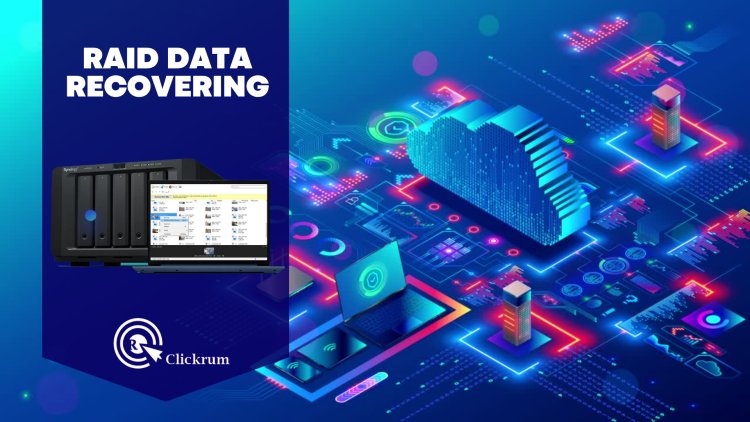RAID Data Recovering: How to recover data from corrupted RAID?
Data is the lifeblood that powers businesses, empowers organizations, and safeguards priceless memories in the vast digital landscape. The integrity and availability of data must be maintained given its exponential growth. RAID (Redundant Array of Independent Disks) technology can be used in this situation to increase data security and provide fault tolerance.

Even the most resilient RAID systems, however, are not impervious to data loss. In this blog post, we will delve into practical methods for protecting and recovering your digital fortress while also delving into the world of data recovery RAID and the intricate workings of RAID configurations.
Recognizing RAID
Restoring data from a RAID storage architecture or infrastructure is referred to as RAID data recovery. To extract and restore data from one or more RAID drives and storage components, it combines automated and manual data recovery processes. RAID data recovery can be used with hardware-based RAID as well as software-based RAID.
RAID is a storage technology that creates a single logical unit out of multiple physical hard drives, improving performance and adding redundancy. RAID levels, which are different configurations for RAID arrays, each have their own distinct advantages and characteristics:
By striping data across multiple drives, RAID 0 boosts performance and capacity but lacks fault tolerance. It can be difficult to recover data from a failed RAID 0 array.
Data redundancy and increased reliability are ensured by RAID 1's complete mirroring of data across multiple drives. Data recovery is made easier by RAID 1 arrays' increased resistance to drive failures.
RAID 5: Increases performance and fault tolerance by distributing data and parity information across multiple drives. Using parity information, the array can be rebuilt in the event of a drive failure.
Having more redundancy than RAID 5, RAID 6 is comparable to RAID 5. Without any data loss, RAID 6 can withstand the simultaneous failure of two drives. Combining mirroring (RAID 1) and striping (RAID 0), RAID 10 (also known as RAID 1+0) improves performance and redundancy. One of the most dependable RAID configurations is RAID 10.
RAID Systems Data Loss
Despite their durability, RAID systems are still susceptible to data loss from a variety of causes, such as hardware malfunctions, software errors, power outages, human error, or natural disasters. A critical situation where data is unavailable or compromised can result from one or more drives failing in a RAID array.
RAID Data Recovery Techniques
- Identify the Issue: It's critical to accurately assess the situation if data loss occurs in a RAID system. The RAID level, the quantity of failed drives, and the kind of failure (logical or physical) should all be noted. Your efforts at data recovery will be guided by this information.
- Look for Expert Assistance: RAID data recovery is a difficult process that needs specialized knowledge and equipment. Hire a data recovery company with experience working with RAID arrays. They have the skills, infrastructure, and resources required to accurately diagnose and successfully recover your data.
- Avoid attempting DIY recovery: Unless you have in-depth knowledge and experience with RAID systems, it's imperative to repress the urge to attempt DIY data recovery. Mismanagement of the recovery procedure can make things worse and result in permanent data loss.
- Maintain the Drives: Make sure that failed drives are turned off and kept in a controlled environment to prevent further damage. Without expert advice, avoid attempting to repair or rebuild the array because you risk accidentally overwriting important data.
- Full Reconstruction: Using drive imaging, parity information, and other specialized techniques, professional data recovery experts reconstruct the RAID array. To ensure the greatest chance of success with the recovery, they carefully extract and put together the data.
Keeping RAID Data Loss at Bay
Although RAID services for data recovery can be very effective, it is always preferable to avoid data loss in the first place. Here are some precautions to take into account:
- Regular Backups: Keep regular, consistent backups of your important data, ideally off-site as well. Check the integrity of your backups frequently to make sure they are trustworthy.
- Monitoring and Upkeep: Install reliable monitoring systems to find drive failure or RAID degradation early on. Update software and firmware frequently to reduce potential vulnerabilities.
- Power Protection: To protect your RAID array from unexpected power surges or outages and reduce the chance of data corruption, invest in uninterruptible power supply (UPS) systems.
- Drive replacement that is proactive: Replace aging or failing drives in accordance with the suggested manufacturer's lifespan recommendations. This aids in avoiding cascading failures, which could jeopardize the entire array.
How can a corrupted RAID be repaired?
It can be difficult and delicate to recover data from a corrupted RAID (Redundant Array of Independent Disks). To prevent additional data loss or damage, it is imperative to approach the recovery carefully. The following procedures can assist you in recovering data from a corrupted RAID:
- Determine the Problem: Identify the type of corruption, such as a physical or logical flaw. Your recovery efforts will be guided by this, which will also help you choose the best course of action.
- Look for Expert Assistance: RAID data recovery is a specialty area requiring knowledge and specialized equipment. Hire the assistance of a reputable data recovery business that has handled RAID recoveries before. They are equipped with the skills, materials, and infrastructure required to manage intricate RAID recoveries successfully.
- Not Initialize or Rebuild the Array: Rebuilding or initializing the RAID array should not be attempted as this could erase important data or make the corruption worse. The RAID configuration must be kept in its original state.
- Protect the drives: Make sure the drives are kept in a controlled environment and turn off the RAID array. Without expert advice, avoid attempting to fix or replace the drives as this could result in more damage or data loss.
- Give Detailed Information: Give a professional data recovery service as much information as you can when working with them. Included in this are the RAID level, configuration, any error messages or symptoms noticed, and any prior attempts at recovery. They will be able to tailor their recovery strategy with the help of this information. A thorough diagnostic and analysis of the RAID drives will be carried out by the data recovery business. They will determine the extent of the corruption and evaluate whether the data can be recovered.
- Rebuilding the RAID Array: In order to access and extract the data, the RAID array must be rebuilt during the recovery process. This could entail methods like rebuilding the array, fixing logical errors, or directly extracting data from the individual drives.
- Data Extraction and Recovery: After the RAID array has been rebuilt, the data will be extracted and recovered by the data recovery specialists. To ensure the greatest chance of success with recovery, they use specialized equipment and methods.
- Data Integrity Check: To make sure that the recovered data is accurate and complete, the data recovery company will carry out a data integrity check after the recovery process. To ensure the integrity of the recovered files and folders, they will verify them.
- Transfer and Restoration: The data will then be restored and transferred to the safe storage medium of your choice. The data can then be restored to the original location or to a different storage option.
Keep in mind that RAID data recovery is a challenging process that calls for professional knowledge. Self-help data recovery from a corrupted RAID can result in further data loss or irreparable harm. It is strongly advised to speak with and retain the services of an established data recovery business with a focus on RAID recoveries.
Conclusion
Data storage has been revolutionized by RAID technology, which provides better performance and data redundancy. Data loss, however, is still a possibility in RAID systems for a number of reasons. To ensure the greatest recovery success in such circumstances, it is essential to seek professional data recovery RAID services.
Implement strong data protection strategies and maintenance procedures because, as they say, prevention is always preferable to cure when it comes to protecting your digital fortress. By doing this, you can reduce the chance of data loss and preserve the availability and integrity of your vital information.













